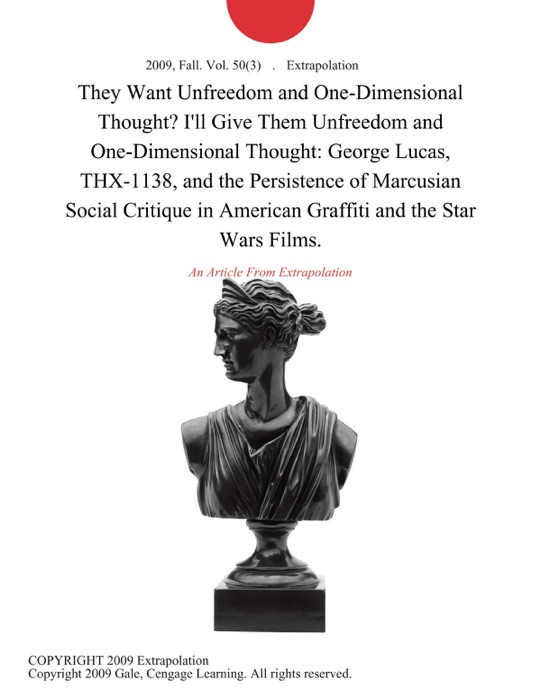(Download) "They Want Unfreedom and One-Dimensional Thought? I'll Give Them Unfreedom and One-Dimensional Thought: George Lucas, THX-1138, and the Persistence of Marcusian Social Critique in American Graffiti and the Star Wars Films." by Extrapolation ~ eBook PDF Kindle ePub Free

eBook details
- Title: They Want Unfreedom and One-Dimensional Thought? I'll Give Them Unfreedom and One-Dimensional Thought: George Lucas, THX-1138, and the Persistence of Marcusian Social Critique in American Graffiti and the Star Wars Films.
- Author : Extrapolation
- Release Date : January 22, 2009
- Genre: Language Arts & Disciplines,Books,Professional & Technical,Education,
- Pages : * pages
- Size : 284 KB
Description
Let's say that there was a commercially successful director whose first movie had been moderately successful with critics but a disaster at the box office. Let's further stipulate that this film was a deliberately difficult and noncommercial critique of American Society, a movie remembered decades later by no less an arbiter of commercialized popular culture than Entertainment Weekly as "a head-scratcher of a science-fiction flick" (Nashawaty 94). In light of that director's later success with high school nostalgia and then a decidedly non-head-scratcher variety of science fiction, it would be easy to see the first movie as a rookie idealist's mistake, and that director's later, more commercial and more commercially successful work, as either a sign of someone who has entered reality or as a sign of someone who has sold out. At first glance, the above scenario describes the general arc of George Lucas' career and explains why biographer Dale Pollock calls Lucas a "conservative businessman from Modesto." (1) His first film, THX-1138, did poorly at the box office. And while some critics approvingly noted Lucas' critique of contemporary society, the film has not exactly become a key text in film studies courses. Lucas' second film, American Graffiti, a seemingly straightforward idealization of Lucas' own immersion in cruising and top 40 rock 'n roll during his adolescence in California, was reviewed well in the popular press, (2) received five Academy Award nominations and made lots of money. (3) The film's entrance into pop culture's broad collective memory, as evidenced by its presence on several "best of" lists also suggests that American Graffiti was designed to please American moviegoers rather than critique American society. (4) Academic critics, when not dismissing the film as "a collection of teenage stereotypes" (Bernardoni 28), have tended to see it as ideologically problematic. Frederic Jameson famously anointed American Graffiti as the "inaugural" example of a "new aesthetic discourse": the nostalgia film. For Jameson, this discourse is characterized by a "desperate attempt to appropriate a missing past" that has been "refracted through the iron law of fashion change" (19). (5)